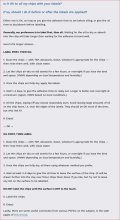Recently I bought a rack of chips that someone had murdered and they had done a terrible job. Once I took off the very 1st label I realized that there was this big gash under the label and basically once you notice something, you can't un-notice it....lol DON'T be that guy. Do us all a favor and either do it right or let someone that knows how to do it, do it for you!
I have chips come to me frequently that some PCF member has started and given up on. They almost always do a hack job on them. The sooner you recognize that you will not be able to do an acceptable job on them the better. In the pics below, the PCF member caught on pretty quickly and only damaged a couple barrels before giving up and leaving the murder job to someone more experienced/capable.
Be careful that you do not cut into the chip when you try your hand at murdering. If you just nick the clay under the inlay it is not a big deal, but if you make a deep (ish) cut you will be able to tell after the label is applied. Some might not care, but to me if you butcher the murder job and cut deep into the chip you have basically destroyed the chip. With a deep cut, even with a high quality label on, the cut will be both visible and leave a bump that can be felt. To me, and I am sure many others here, that is just not acceptable.
Here is what I am talking about. 1st pic is a pic of a chip that another member tried to murder. There is just no way to completely cover up that type of cut. All the other pics are of Red Rock $1's that I murdered. They are a great choice for murder as they are both great looking and plentiful at a very reasonable $1/chip. The only caveat is that the murderer needs to know what they are doing.















